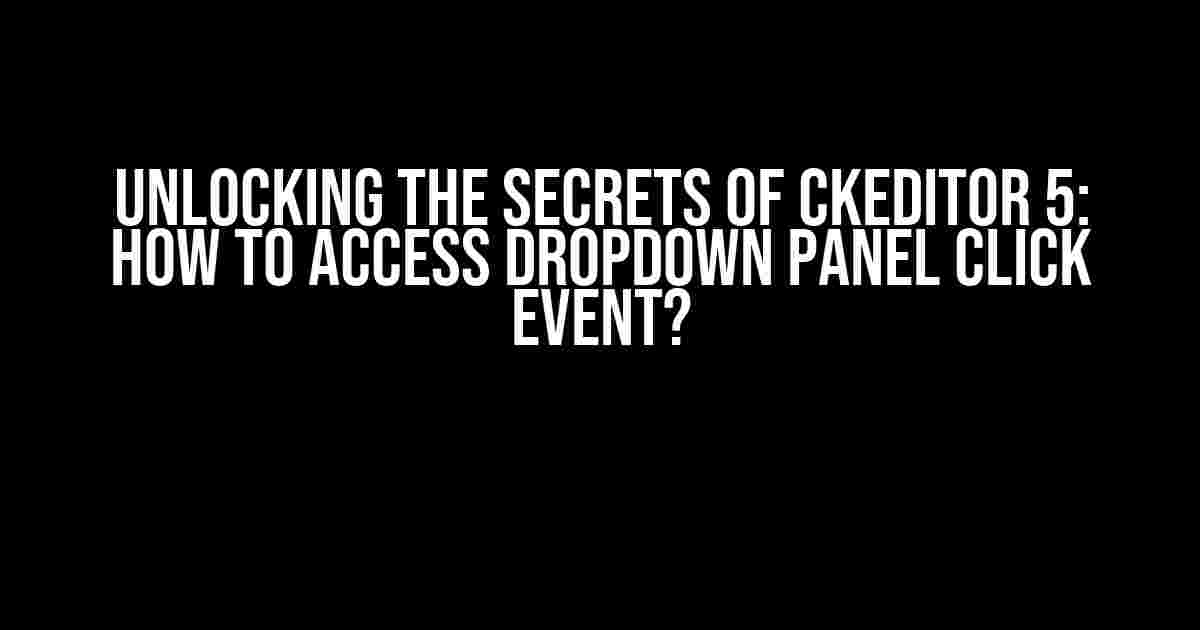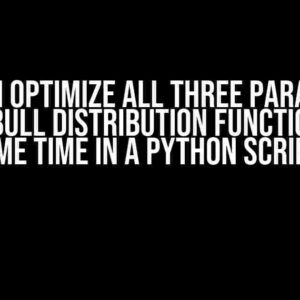CKEditor 5, the powerful and feature-rich WYSIWYG editor, has taken the world of content creation by storm. With its cutting-edge technology and extensive customization options, it’s no wonder that developers and content creators alike are flocking to this incredible tool. However, as with any complex piece of software, navigating its intricacies can be a daunting task. One such puzzle that often leaves users stumped is accessing the dropdown panel click event in CKEditor 5. Fear not, dear reader, for we’re about to embark on a thrilling adventure to unravel the mystery of this elusive event!
Why Do I Need to Access the Dropdown Panel Click Event?
Before we dive into the nitty-gritty of accessing the dropdown panel click event, let’s take a step back and understand why this event is so crucial. The dropdown panel, also known as the “Contextual Balloon,” is a fundamental component of CKEditor 5. It provides a convenient way to access various editing options, such as formatting, links, and images, without cluttering the main toolbar. By accessing the dropdown panel click event, you can:
- Customize the dropdown panel’s behavior to suit your application’s specific needs.
- Implement custom logic or actions when a user interacts with the dropdown panel.
- Enhance the overall user experience by providing a more streamlined and intuitive editing process.
The Elusive Dropdown Panel Click Event: Where to Find It?
Unlike other events in CKEditor 5, the dropdown panel click event is not explicitly exposed through the API. Don’t worry; we’ll show you how to access it using a clever workaround. Before we begin, make sure you have a basic understanding of CKEditor 5’s architecture and the concept of ” Observables” in JavaScript.
Observables to the Rescue!
In CKEditor 5, many events are implemented using Observables, a powerful pattern that allows for efficient and flexible event handling. To access the dropdown panel click event, we’ll need to tap into the Observatory, CKEditor 5’s event hub. Create a new instance of the `Editor` class and get a reference to the `View` object:
import ClassicEditor from '@ckeditor/ckeditor5-editor-classic/src/classiceditor';
const editor = ClassicEditor
.create( document.querySelector( '#editor' ) )
.then( editor => {
const view = editor.editing.view;
// ...
} );
Get Ready for Some Serious DOM Navigation
Next, we’ll need to navigate the DOM to reach the dropdown panel’s container element. This is where things get a bit tricky. You’ll need to traverse the DOM tree to find the `ck-balloon-panel` element, which is the parent container of the dropdown panel:
const view = editor.editing.view;
const dropdownPanelContainer = view.domConverter.domRoot.querySelector( '.ck-balloon-panel' );
The Click Event: Finally!
Now that we have a reference to the dropdown panel’s container element, we can use the `addEventListener` method to capture the click event:
dropdownPanelContainer.addEventListener( 'click', event => {
// This is where the magic happens!
console.log( 'Dropdown panel click event caught!' );
// Implement your custom logic here
} );
Beware of the Bubbling Effect
When working with events in CKEditor 5, it’s essential to be aware of the bubbling effect. In our case, the click event will bubble up the DOM tree, so we need to ensure that we’re targeting the correct element. Use the `event.stopPropagation()` method to prevent the event from propagating further up the tree:
dropdownPanelContainer.addEventListener( 'click', event => {
event.stopPropagation();
console.log( 'Dropdown panel click event caught!' );
// Implement your custom logic here
} );
Putting It All Together: A Real-World Example
Let’s create a simple example that demonstrates how to access the dropdown panel click event in CKEditor 5. We’ll add a custom button to the dropdown panel and log a message to the console when it’s clicked:
<div id="editor"></div>
<script>
import ClassicEditor from '@ckeditor/ckeditor5-editor-classic/src/classiceditor';
import { addWidget } from '@ckeditor/ckeditor5-widget/src/utils';
ClassicEditor
.create( document.querySelector( '#editor' ) )
.then( editor => {
const view = editor.editing.view;
const dropdownPanelContainer = view.domConverter.domRoot.querySelector( '.ck-balloon-panel' );
// Create a custom button
const customButton = document.createElement( 'button' );
customButton.innerHTML = 'Custom Button';
customButton.className = 'ck-button';
// Add the button to the dropdown panel
const dropdownPanelButtonsContainer = dropdownPanelContainer.querySelector( '.ck-balloon-panel__buttons' );
dropdownPanelButtonsContainer.appendChild( customButton );
// Access the dropdown panel click event
dropdownPanelContainer.addEventListener( 'click', event => {
event.stopPropagation();
if ( event.target === customButton ) {
console.log( 'Custom button clicked!' );
}
} );
} );
</script>
Conclusion: Unleashing the Power of CKEditor 5
Accessing the dropdown panel click event in CKEditor 5 may seem daunting at first, but with the right combination of Observables, DOM navigation, and event handling, you can unlock the full potential of this incredible WYSIWYG editor. By following the steps outlined in this article, you’ll be able to customize the dropdown panel’s behavior, implement custom logic, and create a more seamless user experience.
Remember, the key to mastering CKEditor 5 lies in understanding its architecture and leveraging the power of Observables. With practice and patience, you’ll be creating stunning content experiences that leave your users in awe.
So, what are you waiting for? Dive into the world of CKEditor 5 and start unleashing your creativity!
| Event | Description |
|---|---|
| dropdownPanelClick | Emitted when the dropdown panel is clicked. |
| dropdownPanelOpen | Emitted when the dropdown panel is opened. |
| dropdownPanelClose | Emitted when the dropdown panel is closed. |
For more information on CKEditor 5 events, please refer to the official documentation.
Here is the FAQ section about “How to access dropdown panel click event in CKEditor5?” :
Frequently Asked Question
Get the answers to your most pressing questions about accessing dropdown panel click events in CKEditor5.
How do I access the dropdown panel click event in CKEditor5?
You can access the dropdown panel click event in CKEditor5 by using the `editor.ui.componentFactory` to create a custom dropdown panel and then listen to the `execute` event. For example: `editor.ui.componentFactory.create( ‘dropdown’, { onView: () => { console.log( ‘Dropdown panel clicked!’ ); } } );`
What is the best way to handle multiple dropdown panels in CKEditor5?
When working with multiple dropdown panels, it’s best to assign a unique `id` to each panel and then use that `id` to target the specific panel you want to handle. For example: `editor.ui.componentFactory.create( ‘dropdown’, { id: ‘myDropdown’, onView: () => { console.log( ‘My dropdown panel clicked!’ ); } } );`
Can I access the dropdown panel click event in CKEditor5 using JavaScript only?
Yes, you can access the dropdown panel click event in CKEditor5 using JavaScript only. Simply use the `editor.element.addEventListener` to listen to the `click` event on the dropdown panel element. For example: `editor.element.addEventListener( ‘click’, event => { if ( event.target.hasClass( ‘ck-dropdown-panel’ ) ) { console.log( ‘Dropdown panel clicked!’ ); } } );`
How do I prevent the default dropdown panel behavior in CKEditor5?
To prevent the default dropdown panel behavior in CKEditor5, you can use the `event.preventDefault()` method in your event listener. For example: `editor.ui.componentFactory.create( ‘dropdown’, { onView: event => { event.preventDefault(); console.log( ‘Dropdown panel clicked!’ ); } } );`
Are there any limitations to accessing dropdown panel click events in CKEditor5?
One limitation to accessing dropdown panel click events in CKEditor5 is that the `execute` event is only fired when the dropdown panel is opened, not when it’s closed. If you need to detect when the panel is closed, you’ll need to use a workaround, such as listening to the `blur` event on the editor element.



